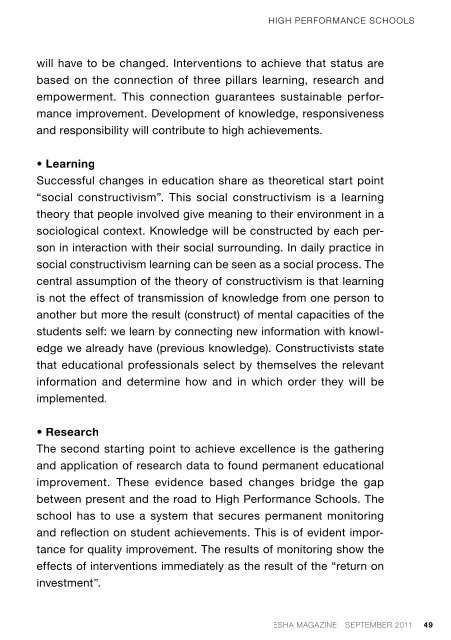Magazine - ESHA
Magazine - ESHA
Magazine - ESHA
Create successful ePaper yourself
Turn your PDF publications into a flip-book with our unique Google optimized e-Paper software.
will have to be changed. Interventions to achieve that status are<br />
based on the connection of three pillars learning, research and<br />
empowerment. This connection guarantees sustainable perfor-<br />
mance improvement. Development of knowledge, responsiveness<br />
and responsibility will contribute to high achievements.<br />
• Learning<br />
Successful changes in education share as theoretical start point<br />
“social constructivism”. This social constructivism is a learning<br />
theory that people involved give meaning to their environment in a<br />
sociological context. Knowledge will be constructed by each per-<br />
son in interaction with their social surrounding. In daily practice in<br />
social constructivism learning can be seen as a social process. The<br />
central assumption of the theory of constructivism is that learning<br />
is not the effect of transmission of knowledge from one person to<br />
another but more the result (construct) of mental capacities of the<br />
students self: we learn by connecting new information with knowl-<br />
edge we already have (previous knowledge). Constructivists state<br />
that educational professionals select by themselves the relevant<br />
information and determine how and in which order they will be<br />
implemented.<br />
• Research<br />
The second starting point to achieve excellence is the gathering<br />
and application of research data to found permanent educational<br />
improvement. These evidence based changes bridge the gap<br />
between present and the road to High Performance Schools. The<br />
school has to use a system that secures permanent monitoring<br />
and refl ection on student achievements. This is of evident impor-<br />
tance for quality improvement. The results of monitoring show the<br />
effects of interventions immediately as the result of the “return on<br />
investment”.<br />
HIGH PERFORMANCE SCHOOLS<br />
<strong>ESHA</strong> MAGAZINE SEPTEMBER 2011 49


